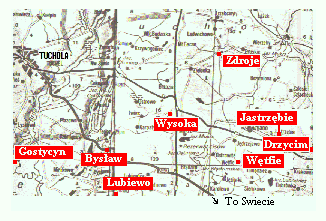
Map of Ancestral Villages Click on the map to learn about another village |
Drzycim, powiat of Swiecie
Parish seat of the Topoliñskis "German Driczmin, a peasant village and parish seat in Swiecie county, its post office and train station in Laskowice. It has been in existence for a very long time.... "The Teutonic Knights had their manorial farm near Gródek: [it was called] the Drzycim house....In 1360, the headman, Jakób, along with the rest of the village, complained about the feudal dues before Count Daniel von Menden in Swiecie: Could the burden [of the dues] not be lightened? Count Daniel [listened] and changed it for them.... "The church here exists from earliest times, mentioned in 1266, then again in 1319, under the title of Our Lady, Most Pure of All Saints, patron of the nobility. The parish lies in the deanery of Swiecie. The church has an old icon of Our Lady and a figure of Jesus on the cross, which in the past and even today are reverenced for miraculous power. Since Polish times, very many religious associations or guilds have been received here: in 1766, there existed guilds near the church for shoemakers, tailors, smiths and wheelwrights.... The old church building was made of wood; the present masonry building dates from 1863-65. The parish comprises close to 40 hamlets, with 3130 souls. A school already existed in 1580; in the hamlets of Rowienica, Wery and Brzeczek [now] there are 82 Catholic children. Other parish schools are in: Gacki, 42 children; Szeroslaw, 95; Lniano, 95; Wetwie, 61; and Gródek, 56...." "In former times, trade fairs were frequently held here, from which commerce the pastor benefited. The village hosted the prefect of Swiecie [and other officials]: in 1580, Dulski, the royal treasurer; Rev. Jablonowski, Poznan provincial and Swiecie prefect; in 1766, Rev. Czartoryski, a high church official.... "Presently Drzycim comprises an area of 3773 morgs [2377 acres], with 110 buildings, 47 occupied houses, 367 Catholics and 56 Protestants. In 1880, a new post office opened in the village." Slownik Geograficzny, Vol. 2, pp. 184-5 (excerpts) |